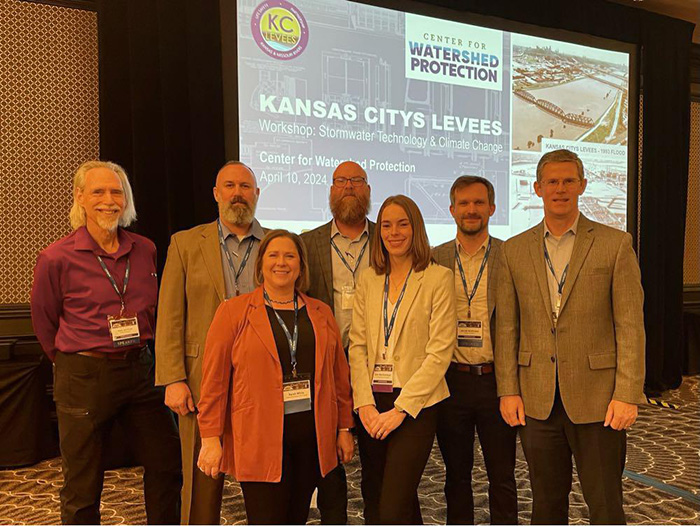USACE Offers Insight on Pump Station Project’s Design Challenges and Strategies
Posted on Tuesday, May 28th, 2024 by Lane OdleIn Federal Services, tagged in

Our Vice President of Federal Services, Jason Davis, presented with Zack Parsons, Project Manager at the United States Army Corps of Engineers (USACE), at the 2024 Center for Watershed Protection (CWP) National Conference. As part of the stormwater quality and climate change workshop, they shared a first-hand account of our Armourdale and CID Levee Units Pump Station Replacement and Repairs project.
This multi-year, complex project came with several interesting design challenges. Here, we explore the project, our approach, and the final results.
Pump Station Project Overview
When we began the project with USACE in 2019, the pump stations ranged in age from 40 to 100 years. They were primarily made of concrete with some brick-and-mortar substructure elements. We were tasked with analyzing the site and providing structural rehabilitation designs. The Affinis team was also responsible for upgrading and increasing the existing pump’s capacity with new replacement pumps having increased capacity.
Structural Design Challenges & Approach
This complex project came with several challenges.
- An expedited schedule
- Extensive data collection
- Inaccurate as-built drawings
- Retrofit solutions
- Small openings for pump installation and structural retrofits
- Unknown material strength and construction
- Increased uplift loading
- Additional fill loading from levee raise
- Bringing structure up to current design criteria
We tackled these using a variety of strategies, including technology, partnerships, and an outside-of the-box design approach.
One of the first challenges we faced was the schedule. Affinis was asked to create two, separate, 100 percent design bid build (DBB) construction contract packages. These included complete structural design modifications and pump upgrades. Both needed to be ready for advertisement within 278 days. But, before design could begin, our team needed to analyze 16 existing pump stations for strength and stability.
Our structural design strategy included lots of data collection. We started by performing boots-on-the-ground surveys and obtained 360° video of the structures. Our partner, Geotechnology, obtained concrete cores and GPR data for the concrete. Along with data collection in the field, our team scanned PDF as-built drawings, so they could be used for creating plans in CAD. We used a finite element model to sharpen the pencil where needed and simplified analysis in other locations for speed. MathCAD was leveraged for hand calculations.
With an accelerated schedule and multiple sites, we used technology to produce a high-quality result. We employed Bluebeam for QC review efficiency. We conducted a structural inspection before construction to verify design assumptions and held weekly design meetings. USACE also provided an embedded structural engineer for the project to keep things moving smoothly and expedite questions designers had during the design phase.
Due to the age of the structures, we needed to create solutions that worked with little room or long unsupported wall spans and/or a large uplift footprint. Our team had to be certain that any proposed fixes would fit within the pump station. For example, if we were adding struts, we had to make sure they could be installed using existing roof hatches, doors, or floor openings.
Pump Design Challenges & Approach
When it came to the design of the pumps, these elements proved challenging:
- Maintaining current ANSI/HI (American National Standards Institute/ Hydraulic Institute) and EM 1110-2-3102 criteria.
- Avoiding a negative impact to pump intake hydraulics criteria/clearances. In some cases, existing pumps did not meet current clearance criteria.
- Coordinating levee raises/hydrology and flow changes.
- Providing a performance design (government cannot specify specific pump manufacturer) when the specific pump curve is unknown.
- Working within the existing electrical service capacity.
Our approach to the pump design used several strategies. We:
- Evaluated pump intake hydraulics for the existing and proposed conditions with structural modifications
- Developed design requirements that included USACE EM 1110-2-3102, ANSI/HI 9.8-2018, and pump manufacturer recommendations.
- Modified the design to not decrease clearances where pump stations already did not meet pump suction bell clearance criteria.
- Compare sump volume to the storage volume available within the wet-well and upstream collection system between the pump operating levels.
- Evaluated each pump station based on gate closure elevations, flows, and river flood elevations using temporary bypass pumping.
- Determined seasonal and stage restrictions for each pump station based on historical flooding and river stages.
- Tested pumps at the manufacturer.
Results
With the new improvements, USACE is seeing an increase in total additional pumping capacity across the projects. In fact, they’ve increased pumping capacity 26,750 GPM. This equates to a 16 percent increase in pumping capacity for the municipal stormwater system for Armourdale and CID Unit leveed areas. It also has resulted in a greater ability to evacuate stormwater at the pump stations during a coincident flood event.